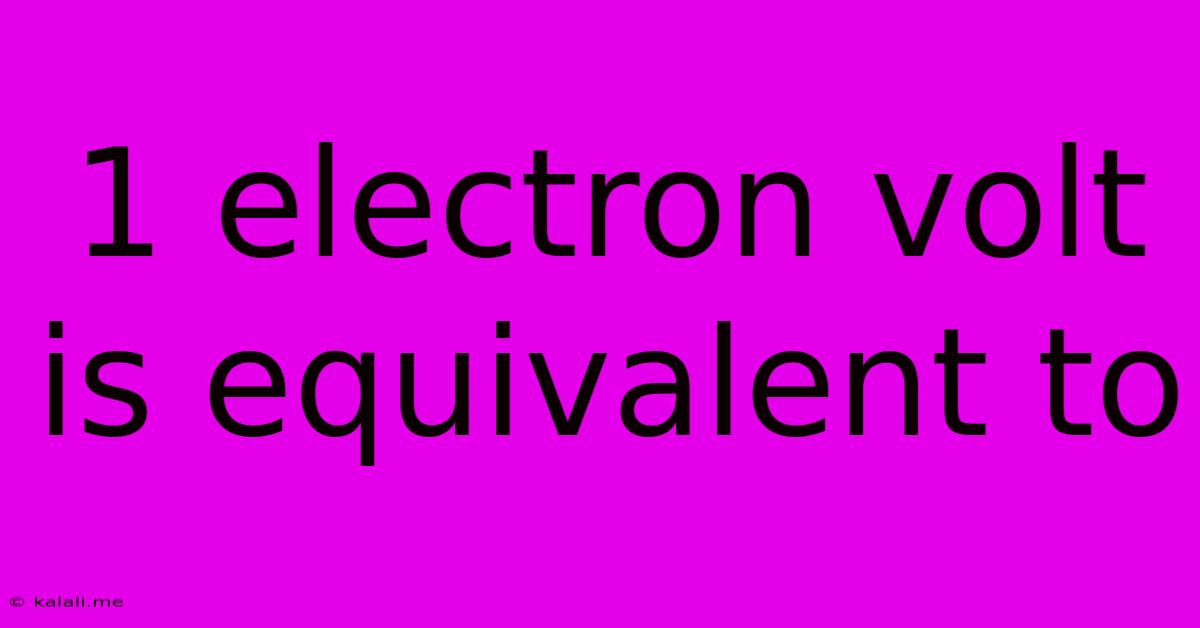1 Electron Volt Is Equivalent To
Kalali
Jun 15, 2025 · 2 min read

Table of Contents
1 Electron Volt is Equivalent To: Understanding Energy at the Atomic Scale
Meta Description: Confused about electron volts (eV)? This article clearly explains what 1 electron volt is equivalent to in joules and other energy units, providing a simple understanding of this crucial unit in physics and chemistry.
The electron volt (eV) is a unit of energy commonly used in atomic, nuclear, and particle physics. While not a standard SI unit, its widespread use stems from its practical convenience in describing the energy scales relevant to these fields. So, what exactly is 1 electron volt equivalent to? Let's break it down.
Defining the Electron Volt
At its core, the electron volt represents the amount of kinetic energy gained by a single electron when it accelerates through an electric potential difference of one volt. This seemingly simple definition holds immense significance in understanding microscopic energy interactions.
1 eV in Joules: The Conversion
The fundamental conversion factor is essential: 1 eV is equivalent to 1.602 x 10<sup>-19</sup> joules (J). The joule (J), the SI unit of energy, is a measure of work done or energy transferred. This conversion factor is derived from the elementary charge of an electron (approximately 1.602 x 10<sup>-19</sup> coulombs).
This means if an electron accelerates through a potential difference of 1 volt, it gains 1.602 x 10<sup>-19</sup> joules of kinetic energy. This seemingly small amount of energy is incredibly significant at the atomic and subatomic levels.
eV in Other Energy Units: Expanding the Perspective
While joules are the standard, expressing energy in eV can often provide a more intuitive understanding within specific contexts. Conversion to other units can further enhance this understanding:
- kiloelectronvolts (keV): 1 keV = 1000 eV
- megaelectronvolts (MeV): 1 MeV = 1,000,000 eV
- gigaelectronvolts (GeV): 1 GeV = 1,000,000,000 eV
- teraelectronvolts (TeV): 1 TeV = 1,000,000,000,000 eV
These larger units become necessary when dealing with higher energy processes, such as those found in particle accelerators or nuclear reactions.
Practical Applications of the Electron Volt
The electron volt's utility extends across various scientific disciplines:
- Atomic Physics: Describing ionization energies (the energy required to remove an electron from an atom) and excitation energies (the energy required to move an electron to a higher energy level).
- Nuclear Physics: Characterizing the energy released in nuclear reactions and decays.
- Particle Physics: Measuring the energy of particles in accelerators and detectors.
- Material Science: Understanding interactions between electrons and materials, such as in electron microscopy and semiconductor physics.
Understanding the electron volt and its equivalence to other energy units is crucial for comprehending the fundamental workings of the physical world at its most basic level. Its practical application makes it a vital tool for scientists and researchers across numerous fields. By mastering this fundamental concept, you gain a deeper appreciation of the energy scales governing atomic and subatomic phenomena.
Latest Posts
Latest Posts
-
Which Of The Following Are Not Antioxidants
Jun 15, 2025
-
Act Score For Western Michigan University
Jun 15, 2025
-
What Is The Difference Between Prose And Verse
Jun 15, 2025
-
This Is The First Step In The Systems Design Phase
Jun 15, 2025
-
The Brightness Of A Star Depends On Its
Jun 15, 2025
Related Post
Thank you for visiting our website which covers about 1 Electron Volt Is Equivalent To . We hope the information provided has been useful to you. Feel free to contact us if you have any questions or need further assistance. See you next time and don't miss to bookmark.